Huawei Y330-U15, Y330-U17, Y330-U11 User Manual




 Y330
Y330
User Guide
Contents
Foreword
Getting started
2Your phone at a glance
3Charging the battery
4Powering on or off your phone
4Dual-card management
6Getting to know your home screen
Basic operations
9Status icons
10Accessing applications
10Texting
Personalizing your phone
12Changing the home screen style
12Changing the theme
12Changing the wallpaper
13Setting the home screen transition effect
13Setting tones
13Changing the lock screen style
14Changing the font size
14 Adjusting the screen brightness
Calls
15Making a call
16Answering or rejecting a call
17What you can do during a call
18Answering a third-party call
18Making a conference call
18Using the call log
Contacts
20 Creating a contact
20Importing or exporting contacts
21Copying contacts
22Searching for a contact
22 Sharing contacts
22 Contact groups
i
Messaging
24 Sending a text message
24Sending a multimedia message
25Replying to a message
25 Searching for a message
25 Managing messages
Browser
27Browsing web pages
27Managing bookmarks
28Setting the home page
28 Clearing your browsing history
29Adding a POP3 or IMAP email account
29Adding an Exchange account
30Sending an email
30 Checking your emails
Multimedia
32 Camera
34Gallery
35Music
Internet connection
38Mobile data connection
39Wi-Fi network
40Sharing your phone's mobile data connection
40Controlling your data usage
Sharing data
43Bluetooth
44Wi-Fi Direct
45Connecting your phone to a computer
File Manager
47Switching between category and list views
47Creating a folder
47Searching for a file
48Copying, cutting, and pasting a file
48Renaming a file
48Deleting a file
48Creating a shortcut for a file or folder
49Checking the storage status
ii
Managing applications
50Downloading applications
50Installing an application
50Viewing applications
51Sharing an application
51 Uninstalling an application
51 Clearing the application cache
Tools
52 Calendar
52 Clock
54Weather
55Calculator
55Notes
56FM radio
Phone settings
58Turning on or off airplane mode
58Tone settings
59Display settings
59Turning on or off do not disturb mode
60Setting the date and time
60Changing the system language
61Setting the PIN of your SIM card
61Accessibility
Legal Notice
iii

Foreword
Foreword
Thank you for choosing the Y330 smartphone!
This guide introduces you to the features and functions of your new phone. Also included are safety precautions you should be aware of, so please read this guide first before you begin using your new phone.
Symbols and definitions
The following symbols are used in this guide.
Note
Highlights important information and tips, and provides additional information.
Indicates potential problems that may arise if the Caution proper care or attention is not taken, such as
device damage or data loss.
Warning
Indicates a potentially hazardous situation which, if not avoided, could result in serious injury.
1
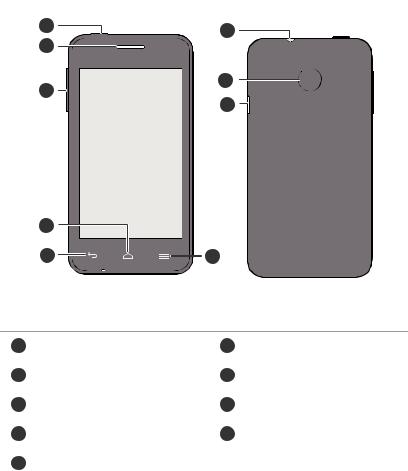
Getting started
Getting started
Your phone at a glance
1
|
Power |
|
Earpiece |
|
|
|
|
3 |
Volume |
4 |
Home |
|
|
|
|
5 |
Back |
6 |
Menu |
|
|
|
|
7 |
USB port |
8 |
Camera |
|
|
|
|
9 |
Headset jack |
|
|
|
|
|
|
2
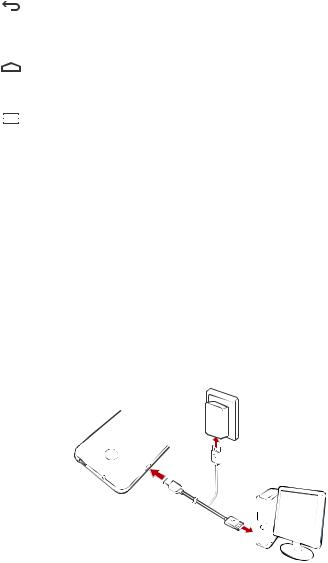
Getting started
Buttons
|
|
|
•Touch to return to the previous screen or exit the |
|
|
Return |
current application. |
|
|
•When you are entering text, touch to hide the |
|
|
|
|
|
|
|
|
onscreen keyboard. |
|
|
|
|
|
|
Home |
Touch to return to the home screen. |
|
|
|
|
|
|
|
•Touch to display an option menu. |
|
|
Menu |
•Touch and hold to display the list of recently used |
|
|
||
|
|
||
|
|
|
applications. |
|
|
|
|
Charging the battery
You can charge the phone in either of the following ways:
•Use the provided USB cable and power adapter to connect your phone to a power socket.
•Use a USB cable to connect your phone to a computer, and touch Charge only on the USB connection methods screen.
3
Getting started
Important information about the battery
•Rechargeable batteries have a limited lifecycle and may eventually need to be replaced. If you notice significantly reduced battery life, replace the battery.
•If your phone has been running for long periods of time, especially in hot environments, heat may be pushed to the surface of the phone. If your phone is overheating, cease using it immediately and unplug it from any power source to let it cool down. Do not hold on to the phone for too long to avoid burn injuries.
•Use the original battery, power adapter, and USB cable to charge your phone. Using third-party accessories may reduce your phone performance or pose security risks. When your phone is charging, do not operate it or cover the phone or power adapter with any object.
•The time required to fully charge the battery depends on the ambient temperature and age of the battery.
•If your phone is very low on power, it plays an alert tone and displays a message. If the battery level is extremely low, your phone automatically powers off.
•If the battery power is depleted, you may not be able to power on your phone immediately after you begin charging the battery. This is normal. Allow the battery to charge for a few minutes before attempting to power on your phone.
Powering on or off your phone
•To power on your phone, press and hold the power button.
•To power off your phone, press and hold the power button to display an option menu, and then touch Power off > OK.
Dual-card management
Your phone supports dual card dual standby mode of WCDMA+GSM. You can use one card for your personal life and one card for work.
4
Getting started
Enabling or disabling a SIM card
You can install a WCDMA and GSM card on your phone and use one or both of them at the same time. When you do not need to use a SIM card, disable it.
1.On the home screen, touch  then the All tab.
then the All tab.
2.Under WIRELESS & NETWORKS, touch SIM card management.
3.On the SIM card management screen, touch the switch beside the SIM card to enable or disable the corresponding SIM card.
Setting the default SIM card for data services
You can set a default SIM card for data services.
1.On the home screen, touch  then the All tab.
then the All tab.
2.Under WIRELESS & NETWORKS, touch SIM card management.
3.Under SIM card management, touch Data connection, and select the SIM card you want to set as the default card.
5
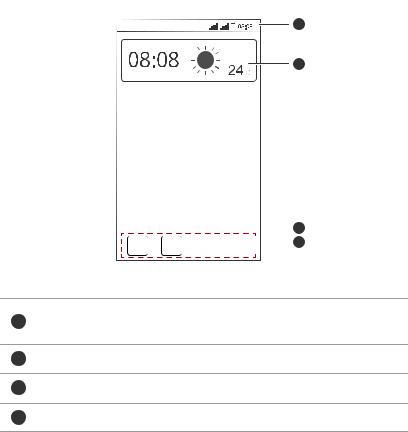
Getting started
Getting to know your home screen
Your home screens are where you'll find your favorite widgets and all your applications. We did away with the application list to give you a more convenient and direct path to your applications. The default home screen is shown below.



 3
3 

 4
4
Status bar: displays notifications and icons. Flick down from the status bar to open the notification panel.
Display area: displays application icons, folders, and widgets.
3Screen position indicator: shows the current screen's position.
4Dock: displays your most common applications.
Switching between home screens
Running out of space on the home screen? Not to worry. Your phone lets you create more home screens for various applications and widgets.
6
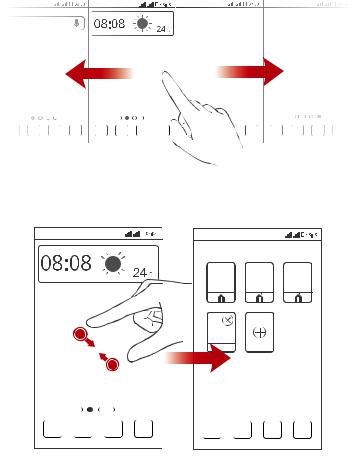
Getting started
• Flick left and right across the screen to switch between the home screens.
•Pinch two fingers together to display the home screen thumbnails. Touch a thumbnail to enter that particular home screen.
Taking a screenshot
Want to share an interesting scene in a movie or show off your new high score in a game? Take a screenshot and share away.
Press the power and volume down buttons simultaneously to take a
screenshot. Then, open the notification panel and touch  to share the screenshot. By default, screenshots are saved to the Pictures folder in File Manager.
to share the screenshot. By default, screenshots are saved to the Pictures folder in File Manager.
7
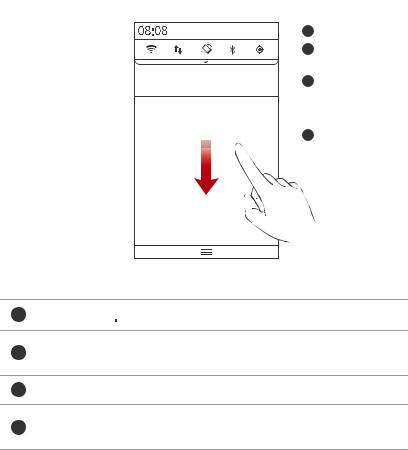
Getting started
Auto-rotate screen
Your phone features a tilt sensor. If you rotate your phone when browsing a web page or viewing a photo, your screen automatically changes between landscape and portrait view. You'll also be able to enjoy tilt sensor-based applications, such as racing games.
To turn on or off the auto-rotate screen function, flick down from the status
bar to open the notification panel, and touch 
 .
.
Using the notification panel
Flick down from the status bar to open the notification panel.


 1
1  2
2
 3
3
 4
4
Touch 

 to display the settings screen.
to display the settings screen.
Touch the switch shortcuts on the notification panel to turn on or off the functions.
3Touch Clear to delete all notifications.
Touch an application to start it and flick left or right across a
4notification to dismiss it.
8
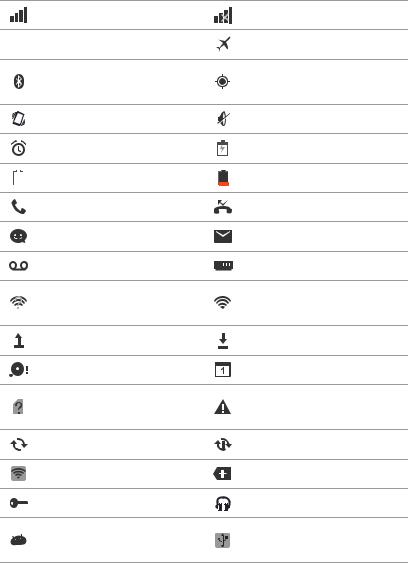
Basic operations
Basic operations
Status icons |
|
|
Signal strength |
No signal |
|
Roaming |
Airplane mode enabled |
|
Bluetooth on |
Receiving location data |
|
from GPS |
||
|
||
Vibration mode enabled |
Silence mode enabled |
|
Alarms enabled |
Charging |
|
Battery full |
Battery low |
|
Call in progress |
Missed calls |
|
New messages |
New emails |
|
New voicemails |
Select input method |
|
Wi-Fi network available |
Connected to a Wi-Fi |
|
network |
||
|
||
Uploading data |
Downloading data |
|
Phone memory full |
Upcoming events |
|
No SIM card found |
Sign-in or synchronization |
|
problem |
||
|
||
Synchronizing data |
Synchronization failed |
|
Portable Wi-Fi hotspot on |
More notifications |
|
Connected to a VPN |
Headset plugged in |
|
USB debugging mode |
USB tethering on |
|
enabled |
||
|
9

Basic operations
Accessing applications
Starting applications and switching between them
On the home screen, touch an application icon to open it.
To switch to another application, touch  to return to the home screen, and touch the icon of the application you want to open.
to return to the home screen, and touch the icon of the application you want to open.
Viewing recently used applications
Touch and hold  to display the list of recently used applications. You can then:
to display the list of recently used applications. You can then:
•Touch an application to start it.
•Flick left or right across an application or touch  on its right upper corner to dismiss it.
on its right upper corner to dismiss it.
•Touch  to clear the list.
to clear the list.
Texting
Your phone comes with multiple text input methods. You can quickly enter text using the onscreen keyboard.
•Touch a text box to bring up the onscreen keyboard.
•To hide the onscreen keyboard, touch  .
.
Selecting an input method
1.On the text input screen, flick down from the status bar to open the notification panel.
2.Touch  to select an input method.
to select an input method.
To change your phone's default input method, touch  on the home screen. Under All, touch Language & input > Default to select an input method.
on the home screen. Under All, touch Language & input > Default to select an input method.
10
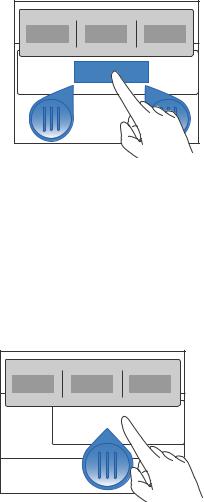
Basic operations
Editing text
Discover how to select, cut, copy, and paste text on your phone.
.KRRU .[G]KO |
• Select text: Touch and hold the text to bring up 
 . Then drag
. Then drag  and
and
 to select more or less text, or touch Select all to select all text in a text box.
to select more or less text, or touch Select all to select all text in a text box.
•Copy text: Select text and touch Copy.
•Cut text: Select text and touch Cut.
•Paste text: Touch where you want to insert the text, drag  to move the insertion point, and touch Paste to paste the text you copied or cut.
to move the insertion point, and touch Paste to paste the text you copied or cut.
 .KRRU
.KRRU
11
Personalizing your phone
Personalizing your phone
Changing the home screen style
Your phone supports the standard and simple home screen styles.
1.On the home screen, touch  .
.
2.Under All, touch Home screen style.
3.Choose Simple or Standard and touch APPLY.
Changing the theme
Changing the theme
1.On the home screen, touch  .
.
2.Select a theme and touch APPLY.
Customizing a theme
1.On the home screen, touch  .
.
2.Under Local, touch CUSTOMIZE.
3.From the element list, choose the element you want to modify.
Changing the wallpaper
1.On the home screen, touch and hold a blank area to display the Set Home Screen dialog box.
2.Touch Wallpapers.
3.On the Wallpaper screen, you can:
•Touch Lock screen wallpaper to set the wallpaper displayed on the phone lock screen.
•Touch Home screen wallpaper to set the home screen wallpaper.
12
Personalizing your phone
•Touch Random change to have the home screen wallpaper change randomly.
Setting the home screen transition effect
1.On the home screen, touch and hold a blank area to display the Set Home Screen dialog box.
2.Touch Transitions.
3.Select a home screen transition effect.
Setting tones
1.On the home screen, touch  .
.
2.Under All, touch Sound.
3.Touch Phone ringtone or Notification tone, and choose either of the following tabs:
•Ringtone: Choose from the default selection.
•Music: Choose from the audio files you have saved to your phone.
4.Touch APPLY.
Changing the lock screen style
Unlocking the screen with a pattern
1.On the home screen, touch  .
.
2.Under All, touch Security.
3.Touch Screen lock > Pattern.
4.Follow the onscreen instructions to set a screen unlock pattern.
After a pattern is set, you will have to draw it every time you want to unlock the phone screen.
13

Personalizing your phone
Unlocking the screen with a PIN
1.On the home screen, touch  .
.
2.Under All, touch Security.
3.Touch Screen lock > PIN.
4.Follow the onscreen instructions to set a screen unlock PIN.
After a PIN is set, you will have to enter it every time you want to unlock the phone screen.
Unlocking the screen with a password
1.On the home screen, touch  .
.
2.Under All, touch Security.
3.Touch Screen lock > Password.
4.Follow the onscreen instructions to set a screen unlock password. Repeat the password and touch OK.
After a password is set, you will have to enter it every time you want to unlock the phone screen.
Changing the font size
1.On the home screen, touch  .
.
2.Under All, touch Display.
3.Touch Font size and select a font size.
Adjusting the screen brightness
1.On the home screen, touch  .
.
2.Under All, touch Display.
3.Touch Brightness.
You can also flick down from the status bar to open the notification panel and adjust the screen brightness using the switch shortcuts.
14

Calls
Calls
Making a call
Smart dialing
Smart dialing lets you quickly find contacts by entering parts of their names or numbers.
1.On the home screen, touch  .
.
2.Enter the initials or first few letters of a contact's name, or part of the contact's phone number. Matching contacts in your phone and phone numbers in your call log are then displayed in a list.
3.From the list, select the contact you want to call.
4. Touch 1 or 2 to make a call.
5. To end the call, touch  .
.
Making an emergency call
In the event of an emergency, you will still be able to make emergency calls without the use of a SIM card. However, you must still be under the coverage area.
1.On the home screen, touch  .
.
2.Enter your local emergency number and touch  .
.
 Emergency calls are subject to cellular network quality, use environment, service provider policies, and local laws and regulations. Never rely solely on your phone for critical communications when emergencies occur.
Emergency calls are subject to cellular network quality, use environment, service provider policies, and local laws and regulations. Never rely solely on your phone for critical communications when emergencies occur.
15
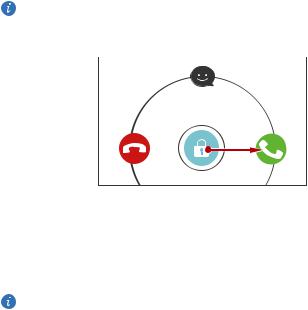
Calls
Answering or rejecting a call
When a call comes in, you can press the volume button to mute the ringtone.
•Drag  right to answer the call.
right to answer the call.
•Drag  left to reject the call.
left to reject the call.
•Drag  up to reject the call and send the caller a message.
up to reject the call and send the caller a message.
On the dialer screen, touch  > Settings > Reject calls with SMS to edit the message that will be sent.
> Settings > Reject calls with SMS to edit the message that will be sent.
16
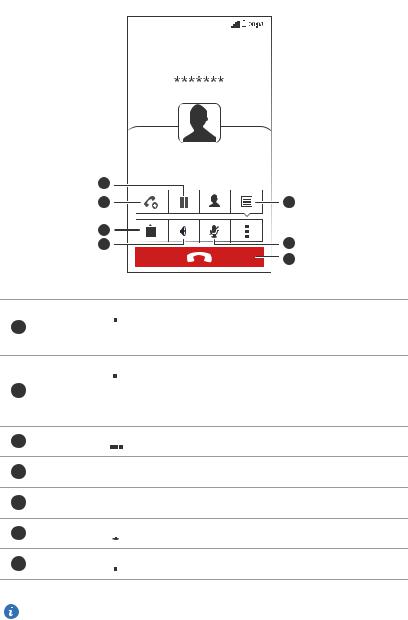
Calls
What you can do during a call
7
3
4 |
6 |
5
Touch  >
>  to place the current call on hold, and touch
to place the current call on hold, and touch  again to resume the call.
again to resume the call.
Touch  >
>  to start a three-way call. Before you use threeway calling, make sure you have subscribed to this service. For details, contact your service provider.
to start a three-way call. Before you use threeway calling, make sure you have subscribed to this service. For details, contact your service provider.
3Touch  to display the dialer.
to display the dialer.
4Touch  to use the speakerphone.
to use the speakerphone.
5Touch  to end the call.
to end the call.
6Touch  to mute or unmute the microphone.
to mute or unmute the microphone.
7Touch  >
>  to display the notepad.
to display the notepad.
To return to the call screen, flick down from the status bar to open the notification panel, and touch Current call.
17
